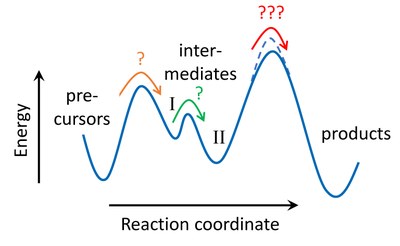Project B - Reaction Kinetics

Coordinating PI
Project PIs
- Prof. Dr. Simone Sanna
- Prof. Dr. Hermann A. Wegner
Background
The surface-assisted synthesis of macromolecular structures usually proceeds through a number of intermediate steps. The Ullmann coupling of halogenated hydrocarbons can serve as a typical example: the reactants are first activated on the surface, the activated species diffuse on the surface and form reactive units (dimers), which in turn react via an organometallic complex as intermediate to form the final product. The total reaction rate thus depends on a multitude of reaction steps; the rate limiting step and the degree of rate control may further change with temperature.
Scientific Goals
In this project area, the kinetics of selected reaction steps, which are crucial for the control of reactions in the framework of on-surface synthesis, will be investigated and energy barriers will be deduced. One focus will be the systematic investigation of the diffusion behavior and thus the mobility of various aromatic compounds on surfaces relevant for on-surface synthesis.
In the interaction of experiment and theory, we then aim to predict the course of on-surface synthesis reactions even for temperature ranges that are not accessible to typical investigations using scanning probe techniques. In this way, new reaction processes and products might be addressed.
The main methods used experimentally are variable temperature scanning tunneling microscopy (also in combinations with fast laser-induced thermal heating) and photoelectron spectroscopy. In theory, the systems are described within the framework of first principles approaches (density functional theory).
